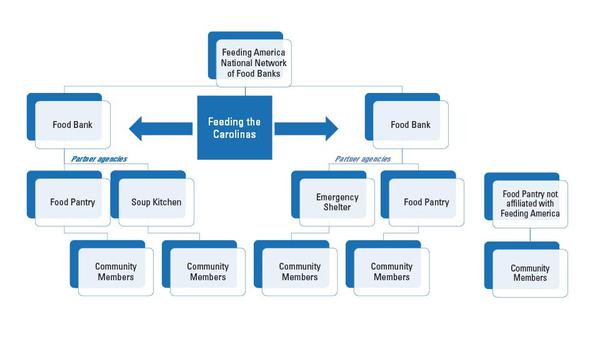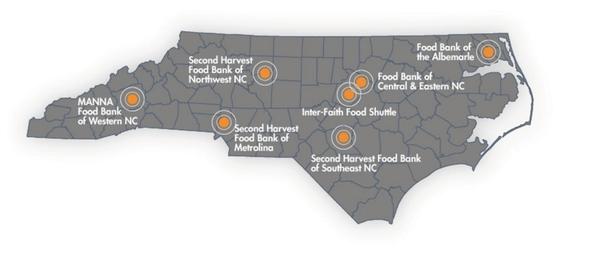The first step toward facilitating relationships between sources of local food and food security organizations is to understand the organizational structure and capacity that these organizations have. Food security organizations include mainly food banks and food pantries. Food banks are large-scale organizations that have warehouses and refrigerated trucks that give them the capacity to source large quantities of food, including fresh produce. Feeding America is a national umbrella organization that connects food banks across the country with each other and with sources of food, including farmers, but also grocery stores, distributors, and wholesalers. Feeding the Carolinas is a strategic alliance of the six food banks and one food recovery organization in North Carolina, along with four food banks in South Carolina that also belong to Feeding America.
|
Feeding the Carolinas is a 501(c)(3) tax-exempt, charitable nonprofit organization. Feeding the Carolinas’ services include:
|
To give an estimate of the capacity of food banks, the Farm to Food Bank program of Feeding the Carolinas was able to procure and move just over 11.3 million pounds of food in North Carolina in fiscal year 2017. The Food Bank of Central and Eastern North Carolina, which operates six branches in 34 counties, distributed 26 million pounds of fresh produce in fiscal year 2017. When food banks receive large donations of fresh food, they often rely on volunteers to help sort and repack products. Most food banks have refrigerated and cold storage space for storing fresh products. The six food banks affiliated with Feeding the Carolinas in North Carolina often share large donations and also receive and redistribute donations to and from other Feeding America Food Banks across state lines (Figure 1).
Most food banks do not distribute food directly to individuals; instead, the food goes to “partner agencies,” including food pantries, soup kitchens, backpack programs, homeless shelters, and other nonprofit organizations that directly serve individuals and families. Each of the six food banks that are affiliated with Feeding America in North Carolina has hundreds of partner agencies within their region. There are also many food security organizations that are not affiliated with Feeding America that distribute food.
Food pantries receive distributions from food banks and provide food directly to those in need. Food pantries may operate out of faith communities, community centers, or other organizations that can provide refrigeration and shelf space for the food they receive from food banks and direct donations. Food pantries vary both in the number of days per week they are open and in their distribution methods and guidelines. Food pantries that are affiliated with the Feeding America network are required to receive food safety training from food banks at the state level, often in collaboration with Cooperative Extension, to ensure the safe handling of all products. Food pantry capacity varies; most food pantries in the national Feeding America network are volunteer-run. In general, food pantries operate on small budgets, relying heavily on volunteer labor and donations. Many are open only once or twice a month, although some are open once a week, or even daily. Food pantries often have limited or no storage capacity, so donations of perishable items need to be carefully coordinated with distribution times and days.
The six food banks in North Carolina can be found on the Feeding the Carolinas’ website (Figure 2). Each food bank has a directory of its partner agencies, which lists their location and hours of operation.
Reference
United States Department of Agriculture (USDA). 2017. Economic Research Service State Fact Sheets: North Carolina. Accessed August 8, 2017.
Publication date: Nov. 8, 2017
LF-15
Other Publications in Farm to Food Bank Resource Guide for North Carolina Cooperative Extension
The use of brand names in this publication does not imply endorsement by NC State University or N.C. A&T State University of the products or services named nor discrimination against similar products or services not mentioned.
N.C. Cooperative Extension prohibits discrimination and harassment regardless of age, color, disability, family and marital status, gender identity, national origin, political beliefs, race, religion, sex (including pregnancy), sexual orientation and veteran status.


